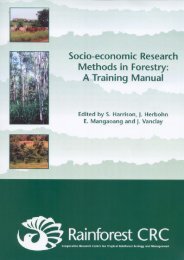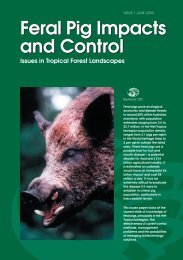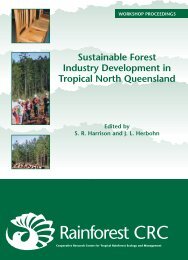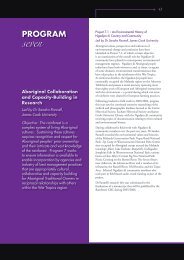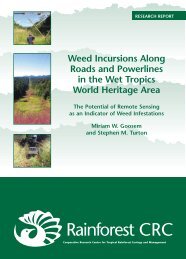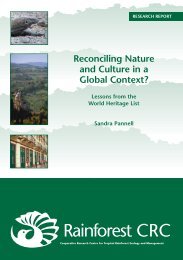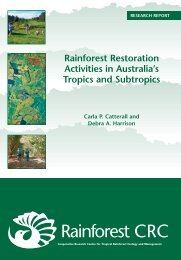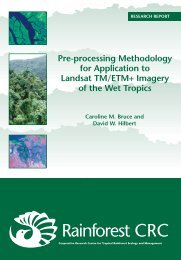Reconciling Nature and Culture in a Global Context? - Rainforest ...
Reconciling Nature and Culture in a Global Context? - Rainforest ...
Reconciling Nature and Culture in a Global Context? - Rainforest ...
You also want an ePaper? Increase the reach of your titles
YUMPU automatically turns print PDFs into web optimized ePapers that Google loves.
S<strong>and</strong>ra Pannelltogether, “they co-evolve” (Dove 1992: 246). This last po<strong>in</strong>t is particularly evident when welook aga<strong>in</strong> at the Wet Tropics nom<strong>in</strong>ation document.The view of nature presented <strong>in</strong> the nom<strong>in</strong>ation document <strong>and</strong> <strong>in</strong> the support<strong>in</strong>g reports as‘fragile’ (see also Figure 2), <strong>and</strong> certa<strong>in</strong> cultures as ‘destructive’, <strong>in</strong>vites <strong>and</strong> encouragessocial <strong>in</strong>tervention <strong>and</strong> environmental preservation. As C<strong>in</strong>di Katz po<strong>in</strong>ts out, “‘preservation’is most commonly accomplished by a physical <strong>and</strong> textual exclusion of sedimented layers ofsocial activity <strong>and</strong> actors, past <strong>and</strong> present” (1998: 54). In def<strong>in</strong><strong>in</strong>g <strong>and</strong> cordon<strong>in</strong>g off natureas patches of protected spaces, science often overlooks historical changes <strong>in</strong> the way natureis perceived <strong>and</strong> <strong>in</strong>fluenced by other ideas 8 . While the nom<strong>in</strong>ation document provides ashort statement on European use of the general region, from the ‘pioneer<strong>in</strong>g graziers’ <strong>and</strong>cedar cutters of the late n<strong>in</strong>eteenth century to the more <strong>in</strong>tensive agricultural pursuits <strong>and</strong>tourist endeavours of the twentieth century, there is no discussion of the cultural processeswhereby the forests of the region were transformed from ‘vile’ <strong>and</strong> ‘useless scrub’ <strong>in</strong>to a‘prist<strong>in</strong>e’ <strong>and</strong> ra<strong>in</strong>forested ‘wilderness’, as now depicted on the World Heritage List. As JaneLennon observes, “many of today’s natural areas <strong>in</strong> Australia were largely ‘wastel<strong>and</strong>s’rema<strong>in</strong><strong>in</strong>g from n<strong>in</strong>eteenth century imperial l<strong>and</strong> settlement schemes” (2000: 182).Science <strong>and</strong> scientists played an important role <strong>in</strong> effect<strong>in</strong>g this transformation <strong>in</strong> perception<strong>and</strong> values. Scientific exploration contributed to the identification of economically valuablefloral species <strong>in</strong> the region <strong>in</strong> the early years of Anglo-Australian settlement, while <strong>in</strong> thetwentieth century science helped shape the Queensl<strong>and</strong> Government’s management of thevast tracts of ‘State Forest’, now part of the Wet Tropics World Heritage Area. In morerecent times, scientific knowledge <strong>and</strong> the pr<strong>in</strong>ciples of scientific management have beenapplied to the development of the region’s agricultural <strong>and</strong> tourism <strong>in</strong>dustries. While the WetTropics today are viewed through the lens of science as one of the rema<strong>in</strong><strong>in</strong>g vestiges of‘pure nature’, <strong>in</strong> more popular read<strong>in</strong>gs of the environment, the grassy, roll<strong>in</strong>g contours of theAtherton Tablel<strong>and</strong>, once covered by the prist<strong>in</strong>e ra<strong>in</strong>forests today valorised by science, arecommonly seen as ‘natural’ spaces as well. Notwithst<strong>and</strong><strong>in</strong>g these contrast<strong>in</strong>g visions, bothviews ultimately deny the social history of the l<strong>and</strong>scapes they behold. As these commentssuggest, our read<strong>in</strong>g of the environment is a cultural practice, <strong>in</strong>formed by specific socialentailments <strong>and</strong> motivated by certa<strong>in</strong> economic <strong>and</strong> political agendas.A poignant example of how ideas about nature <strong>and</strong> culture mediate (<strong>and</strong> at times are theproduct of) the <strong>in</strong>terface of scientific concepts <strong>and</strong> political pressure is provided by a briefexam<strong>in</strong>ation of the names ascribed to the World Heritage Area. The orig<strong>in</strong>al nom<strong>in</strong>ationdocument refers to the approximately 11,000 square kilometres as ‘wet tropical ra<strong>in</strong>forests’, adesignation based upon scientific classification of the region’s vegetation. While this labelsuggests that the entirety of the area <strong>in</strong> question is covered <strong>in</strong> ‘ra<strong>in</strong>forest’, the key supportdocument for the nom<strong>in</strong>ation states that only 6,300 square kilometres of this area is actually‘ra<strong>in</strong>forest’ (RCSQ 1986: 11). The rema<strong>in</strong><strong>in</strong>g area consists of “wet sclerophyll, mangrove,dune <strong>and</strong> swale formations” (IUCN 1988: 11), among other th<strong>in</strong>gs. Aware that less than 60%of the nom<strong>in</strong>ated region constituted actual ‘ra<strong>in</strong>forest’, <strong>in</strong> their consideration of the nom<strong>in</strong>ationthe World Heritage Bureau recommended that the “name of [the] property be reconsidered toreflect the nature of the area” (WHC 1988: 2). The result<strong>in</strong>g name, ‘Wet Tropics’, is thus theproduct of ‘sex<strong>in</strong>g up’ science <strong>and</strong> political sp<strong>in</strong>. As this example suggests, the concept ofnature as a scientific category is also crucial to political discourse, <strong>and</strong> vice versa.8 For example, <strong>in</strong> the latter part of the n<strong>in</strong>eteenth century <strong>and</strong> throughout much of the twentiethcentury, the forests of the regions were commonly described as useless ‘scrub’ or impenetrable‘jungle’ by the Anglo-Australian settlers. As Michael Dove po<strong>in</strong>ts out, ‘jungle’ is an English borrow<strong>in</strong>gof the Urdu word jongal, which <strong>in</strong> its orig<strong>in</strong>al l<strong>in</strong>guistic context <strong>and</strong> usage referred to a “savannavegetation suited to the keep<strong>in</strong>g of livestock” (cited <strong>in</strong> Ellen 1996: 8).8




